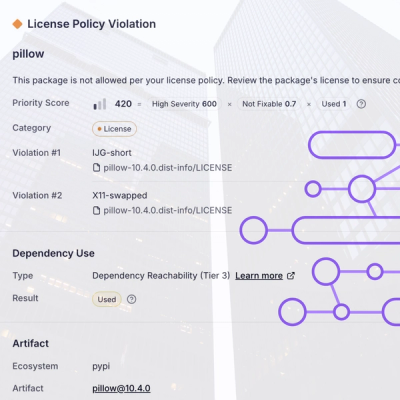
Research
/Security News
Critical Vulnerability in NestJS Devtools: Localhost RCE via Sandbox Escape
A flawed sandbox in @nestjs/devtools-integration lets attackers run code on your machine via CSRF, leading to full Remote Code Execution (RCE).
Compiles, parses Subrip files, segments and generates HLS playlists for them.
This is a sister package to osk/node-webvtt.
For a Subrip file:
00:00:00.000 --> 00:00:01.000
Hello world!
00:00:30.000 --> 00:00:31.000 align:start line:0%
This is a subtitle
00:01:00.000 --> 00:01:01.000
Foo
00:01:50.000 --> 00:01:51.000
Bar
We can parse, segment and create HLS playlists, and compile back to Subrip format:
const subrip = require('node-srt');
const segmentDuration = 10; // default to 10
const startOffset = 0; // Starting MPEG TS offset to be used in timestamp map, default 900000
const parsed = subrip.parse(input);
const compile = subrip.compile(input);
const segmented = subrip.parse(input, segmentDuration);
const playlist = subrip.hls.hlsSegmentPlaylist(input, segmentDuration);
const segments = subrip.hls.hlsSegment(input, segmentDuration, startOffset);
Parses the Subrip file and returns an object with valid === true if parsed correctly and an array of cues parsed.
Each cue can have:
identifier - Id, if any of the cuestart - Start time of cue in secondsend - End time of cue in secondstext - Text of the subtitlestyles - If any of the cueIf the Subrip file is invalid, the parser will throw a ParserError exception. So for safety, calls to parse should be in try catch.
For the above example we'd get:
{
"valid":true,
"cues":[
{
"identifier":"",
"start":0,
"end":1,
"text":"Hello world!",
"styles":""
},
{
"identifier":"",
"start":30,
"end":31,
"text":"This is a subtitle",
"styles":"align:start line:0%"
},
{
"identifier":"",
"start":60,
"end":61,
"text":"Foo",
"styles":""
},
{
"identifier":"",
"start":110,
"end":111,
"text":"Bar",
"styles":""
}
]
}
By default the parser is strict. It will throw errors if:
WEBVTTSetting the option parameter of strict to false will allow files with malformed cues to be parsed. The resulting object will have valid === false and all errors in an errors array.
If strict is set to false, the parser will also not categorize it as an error if a cue starts and ends at the same time. This might be the correct behaviour but changing would introduce a breaking change in version 1.x.
const input = `WEBVTT
MALFORMEDCUE -->
This text is from a malformed cue. It should not be processed.
1
00:00.000 --> 00:00.001
test`;
const result = parse(input, { strict: false });
/*
result = {
valid: false,
strict: false,
cues: [ { identifier: '1', start: 0, end: 0.001, text: 'test', styles: '' } ],
errors: [ { Error: Invalid cue timestamp (cue #0) message: 'Invalid cue timestamp (cue #0)', error: undefined } ]
}
*/
Some Subrip strings may also contain lines of metadata after the initial WEBVTT line, for example:
00:00:00.000 --> 00:00:01.000
Hello world!
By passing { meta: true } to the parse method, these metadata will be returned as an object called meta. For example, parsing the above example:
parse(subrip, { meta: true });
would return the following:
{
"valid":true,
"meta":{
"Kind": "captions",
"Language": "en"
},
"cues":[
{
"identifier":"",
"start":0,
"end":1,
"text":"Hello world!",
"styles":""
}
]
}
If no metadata is available, meta will be set to null in the result if the option is specified.
Compiles JSON from the above format back into a Subrip string. If a meta key is in the input,
it will be compiled as well. The meta value must be an object and each key and value must be a string.
If the object is missing any attributes, the compiler will throw a CompilerError exception. So
for safety, calls to compile should be in try catch.
const input = {
meta: {
Kind: 'captions',
Language: 'en'
},
cues: [{
end: 140,
identifier: '1',
start: 135.001,
text: 'Hello world',
styles: ''
}],
valid: true
};
const result = compile(input);
/*
1
00:02:15.001 --> 00:02:20.000
Hello world
*/
Segments a subtitle according to how it should be segmented for HLS subtitles.
mediasubtitlesegmenter CLIFor the above example:
[
{ duration: 10, cues: [ [Object] ] },
{ duration: 30, cues: [ [Object] ] },
{ duration: 30, cues: [ [Object] ] },
{ duration: 41, cues: [ [Object] ] }
]
Creates a subtitle playlist. For the above:
#EXTM3U
#EXT-X-TARGETDURATION:41
#EXT-X-VERSION:3
#EXT-X-MEDIA-SEQUENCE:0
#EXT-X-PLAYLIST-TYPE:VOD
#EXTINF:10.00000,
0.vtt
#EXTINF:30.00000,
1.vtt
#EXTINF:30.00000,
2.vtt
#EXTINF:41.00000,
3.vtt
#EXT-X-ENDLIST
Creates a list of HLS segments for the subtitles, returning an array of them with filename and content.
[
{
"filename":"0.vtt",
"content":"WEBVTT\nX-TIMESTAMP-MAP=MPEGTS:900000,LOCAL:00:00:00.000\n\n00:00:00.000 --> 00:00:01.000\nHello world!\n"
},
{
"filename":"1.vtt",
"content":"WEBVTT\nX-TIMESTAMP-MAP=MPEGTS:900000,LOCAL:00:00:00.000\n\n00:00:30.000 --> 00:00:31.000 align:start line:0%\nThis is a subtitle\n"
},
{
"filename":"2.vtt",
"content":"WEBVTT\nX-TIMESTAMP-MAP=MPEGTS:900000,LOCAL:00:00:00.000\n\n00:01:00.000 --> 00:01:01.000\nFoo\n"
},
{
"filename":"3.vtt",
"content":"WEBVTT\nX-TIMESTAMP-MAP=MPEGTS:900000,LOCAL:00:00:00.000\n\n00:01:50.000 --> 00:01:51.000\nBar\n"
}
]
For segmenting a Subrip file quickly, you can use the included CLI tool:
./subrip-segment.js -v --target-duration 10 -o ./subs subs.vtt
$ ./subrip-segment.js --help
Usage: subrip-segment [options] <subrip file>
Options:
-h, --help output usage information
-V, --version output the version number
-t, --target-duration [duration] Target duration for each segment in secods, defaults to 10
-o, --output-directory [dir] Output directory for segments and playlist
-v, --verbose Chatty output
-s, --silent No output
This has been written with TDD so we've got a good coverage of the features.
npm install
npm test
mocha -w
<write failing test>
<write passing code>
<lather, rinse, repeat>
mediasubtitlesegmenter from AppleFAQs
SRT parser, compiler, and segmenter with HLS support
The npm package node-srt receives a total of 18 weekly downloads. As such, node-srt popularity was classified as not popular.
We found that node-srt demonstrated a not healthy version release cadence and project activity because the last version was released a year ago. It has 1 open source maintainer collaborating on the project.
Did you know?

Socket for GitHub automatically highlights issues in each pull request and monitors the health of all your open source dependencies. Discover the contents of your packages and block harmful activity before you install or update your dependencies.

Research
/Security News
A flawed sandbox in @nestjs/devtools-integration lets attackers run code on your machine via CSRF, leading to full Remote Code Execution (RCE).

Product
Customize license detection with Socket’s new license overlays: gain control, reduce noise, and handle edge cases with precision.

Product
Socket now supports Rust and Cargo, offering package search for all users and experimental SBOM generation for enterprise projects.